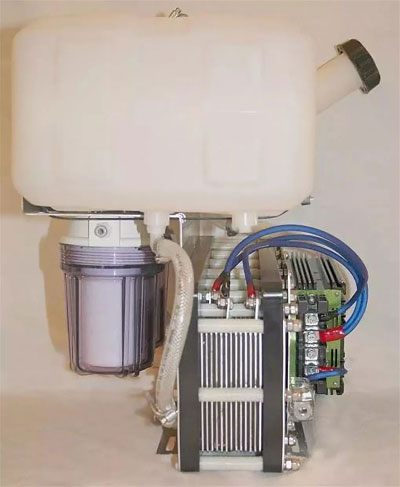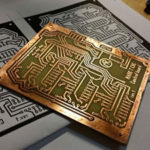Hydrogen is an almost perfect fuel for our planet. The only problem is that it is found on the planet only in combination with other substances. In its pure form, hydrogen on Earth is only 0.00005%. In this regard, the issue of designing hydrogen generators is very relevant. Do not forget that hydrogen is an endless source of energy, practically under our feet.

Content
The device and principle of operation of the hydrogen generator
How it works
The classic apparatus for generating hydrogen includes a tube of small diameter, often with a circular cross section.Under it are special cells with electrolyte. The aluminum particles themselves are located in the lower vessel. The electrolyte in this case is suitable only for the alkaline type. A tank is installed above the feed pump, where condensate is collected. Some models use 2 pumps. The temperature is controlled directly in the cells.
The generator gets gas from the water. Its quality directly affects the amount of impurities in the finished product. So, if water with a high concentration of foreign ions enters the generator, then it will first have to pass through a deionization filter.
Here is how the process of obtaining gas occurs:
- The distillate is split into oxygen (O) and hydrogen (H) during the electrolysis process.
- O2 enters the feed tank and then escapes to the atmosphere as a by-product.
- H2 is supplied to the separator, separated from the water, which then returns to the supply tank.
- Hydrogen is re-passed through a separating membrane, which extracts the remaining oxygen from it, and then enters the chromatographic equipment.

electrolysis method
As mentioned above, there are practically no such inexhaustible energy sources in the world as hydrogen. It should not be forgotten that 2/3 of the World Ocean consists of this element, and in the entire Universe, H2, together with helium, occupies the largest volume. But to get pure hydrogen, you need to split water into particles, and this is not very easy to do.
Scientists after many years of tricks invented electrolysis method. This method is based on placing two metal plates close to each other in water, which are connected to a high voltage source.Next, power is applied - and a large electrical potential actually breaks the water molecule into components, as a result of which 2 hydrogen atoms (HH) and 1 oxygen (O) are released.

This gas (HHO) was named after Australian scientist Yull Brown, who in 1974 patented the creation of an electrolyzer.
Stanley Meyer fuel cell
The US scientist Stanley Meyer invented such an installation that did not use a strong electrical potential, but currents of a certain frequency. The water molecule oscillates in time with the changing electrical impulses and enters into resonance. Gradually, it gains power, which is enough to separate the molecule into components. For such an impact, currents are ten times smaller than for the operation of a standard electrolysis unit.

IMPORTANT! Meyer paid with his life for his invention. He was killed, according to rumors, by order of the magnates, since his invention could kill the oil business in the bud. Nevertheless, some of the scientist's achievements have been preserved, so his contemporaries have the opportunity to try to make such devices.
Benefits of Brown's gas as an energy source
- The water from which HHO is obtained is present on our planet in huge quantities. Accordingly, the sources of hydrogen are practically inexhaustible.
- The combustion of Brown's gas produces water vapor. It can be re-condensed into a liquid and used as a raw material again.
- The combustion of HHO does not release any harmful substances into the atmosphere and does not form by-products other than water. We can say that Brown's gas is the most environmentally friendly fuel in the world.
- When using a hydrogen generator, water vapor is released.Its quantity is enough to maintain a comfortable humidity in the room for a long time.
IMPORTANT! Hydrogen can also be obtained by cracking - oil refining (releases gas as a by-product). This method is cheaper than obtaining by electrolysis, but there may be difficulties in transporting the gas. In addition, the gas produced by electrolysis is much cleaner than that produced by cracking.

The scope of the hydrogen generator
H2 is a modern energy carrier that is actively used in many industrial areas. Here are just a few:
- production of hydrogen chloride (HC)l;
- production of fuel for rocket launchers;
- production of ammonia;
- metal processing and cutting on it;
- development of fertilizers for suburban areas;
- synthesis of nitric acid;
- creation of methyl alcohol;
- food industry;
- production of hydrochloric acid;
- creation of "warm floor" systems.
In addition, HHO has become very useful in everyday life, however, with reservations. First of all, it is used for autonomous heating systems. In addition, Brown's gas is added to gasoline in an attempt to trick the engine and save on fuel.
Both cases have their own characteristics. So, when organizing home heating, you need to take into account that the combustion temperature of HHO is an order of magnitude higher than that of methane. In this regard, it is necessary to purchase a special expensive boiler with a heat-resistant nozzle. Otherwise, the owner and his house will be in considerable danger.

As for the use of a generator in a car, sometimes the system can work - if it is designed correctly. But it is almost impossible to find ideal parameters or a power gain factor.In addition, it is not entirely clear how much the engine life will be reduced, and its replacement will cost a pretty penny.
What is needed to make a fuel cell at home
Creating a hydrogen unit at home is not an easy task. You need to arm yourself not only with a number of tools, but also with the relevant knowledge, as well as diagrams.
Designing a hydrogen generator: diagrams and drawings
The device consists of a reactor with installed electrodes, a PWM generator for power supply, a water seal, wires and hoses connecting the structure. To date, several schemes of electrolyzers are known, where plates or tubes are used as electrodes.
Dry electrolysis devices are also popular. Unlike the classic version, in this unit, the plates are not placed in a container with liquid, but the water itself is directed into the gap between the flat electrodes.
The choice of materials for the construction of a hydrogen generator
To make a generator at home, no special and unusual tools are needed. Here's what you need to prepare:
- hacksaw for working with metal products;
- drill and drills for it;
- set of wrenches;
- flat and slotted screwdrivers;
- angle grinder ("grinder") with a circle for cutting metal;
- multimeter and flowmeter;
- ruler;
- marker.
DIY hydrogen generator: instructions
The process starts with the creation of a hydrogen production cell. In terms of dimensions, it should be slightly less than the internal parameters of the length and width of the generator housing. In height, it is 2/3 of the height of the main building. The cell is made of textolite or plexiglass (wall thickness 5-7 mm).To do this, 5 plates are cut to size, from which a rectangle is glued, and its lower part is not closed by anything.
Using a grinder, electrode plates are cut out of a stainless steel sheet. In size, they should be 10–20 mm smaller than the side walls.
IMPORTANT! To get enough HHO, stainless steel should be sanded on both sides.
In each plate, it is required to drill 2 holes: to supply water to the space between the electrodes and to remove Brown's gas.
Fittings for water supply and gas extraction are inserted into the hardboard walls. The joints where they were attached are carefully treated with sealant. Studs are installed in one of the transparent body parts, and then the electrodes are laid.
IMPORTANT! The plane of the plate electrodes must be even, otherwise the elements may cause a short circuit.
The plates are detached from the sides of the reactor using o-rings, which can be made of silicone, paronite or other material. Having laid the last plate, a sealing ring is mounted, after which the generator is closed with a second hardboard wall. The resulting structure is fastened with washers and nuts.
The generator is connected to a water tank and a bubbler using polyethylene hoses. The contact pads of the electrodes are interconnected, after which power is connected to them. The cell is energized by a PWM generator.
Hydrogen at home: is there any benefit
We note right away: it is unprofitable to use a hydrogen generator for heating a house.You will spend more electricity releasing pure H2 than you will get energy from burning it. So, for 1 kW of heat, 2 kW of electricity is spent, that is, there is no benefit. Easier to install at home any of electric boilers.
To replace 1 liter of gasoline for a car, 4766 liters of pure hydrogen or 7150 liters of detonating gas, 1/3 of which is oxygen, will be required. So far, even the best minds in the world have not developed a unit capable of delivering such performance.

Maintenance of hydrogen generators
The equipment must be carefully maintained. Experts advise to adhere to the following tips:
- do not improve or modify the generator yourself, even if you have a professional engineering drawing;
- it is recommended to install special temperature sensors inside the heat exchanger on the equipment, which will make it possible to control the process of water overheating;
- shut-off valves can be installed in the burner and connected to the temperature sensor. This will allow the appliance to cool properly.
A self-made generator allows you to get hydrogen, but it is mainly used for experiments and gas welding. To heat a considerable structure, the efficiency of the apparatus is simply not enough. And at the same time, one should not forget about the low efficiency of the device, as well as the hassle and cost of assembling it.
Similar articles:






